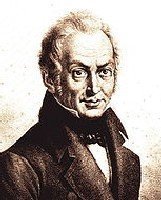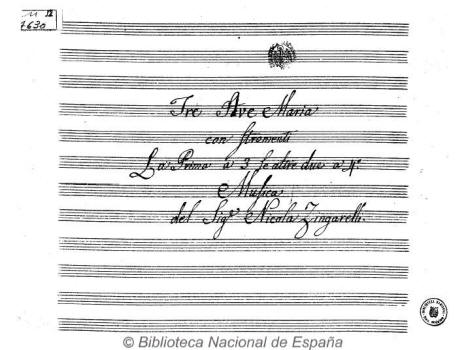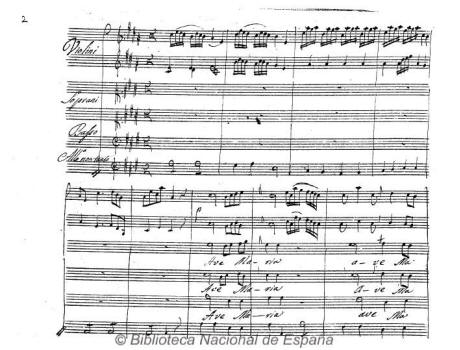Zingarelli, Nicola - Ave Maria
 for SSB and 2 vln, bc
for SSB and 2 vln, bc
 | Composer: Nicola Zingarelli (1752-1837) Aliases, aka: Niccolò Antonio Zingarelli Country of origin / activity: Italy | |
| Text author: traditional | ||
| Arranger / Editor: N/A |
Similar names or titles
| MIDI | MP3 | VID | First name | Last name | Birth | Death | comp | ID # | Title | Voicing | Instrumentation | |
|---|---|---|---|---|---|---|---|---|---|---|---|---|
| 1 | 0 | 0 | 0 | Nicollo | Zingarelli | 1752 | 1837 | 1844 | Ave Maria | SSB | 2 vln, cb | |
| 1 | 0 | 0 | 0 | Nicollo | Zingarelli | 1752 | 1837 | 1844 | Ave Maria | SATB | chamber orchestra | |
| 1 | 0 | 0 | 0 | Nicollo | Zingarelli | 1752 | 1837 | 1844 | Ave Maria | SATB | chamber orchestra | |
| 0 | 0 | 0 | 0 | Nicollo | Zingarelli | 1752 | 1837 | 1844 | Ave Maria | TB | organ | |
| 0 | 0 | 0 | 0 | Nicollo | Zingarelli | 1752 | 1837 | 1844 | Ave Maria | TB | organ | |
| 0 | 0 | 0 | 0 | Nicollo | Zingarelli | 1752 | 1837 | 1844 | Ave Maria | SAB | vln, bc | |
| 0 | 0 | 0 | 0 | Nicollo | Zingarelli | 1752 | 1837 | 1844 | Ave Maria | TTB | organ | |
| 0 | 0 | 0 | 0 | Nicollo | Zingarelli | 1752 | 1837 | 1844 | Ave Maria | TTB | organ | |
| 0 | 0 | 0 | 0 | Nicollo | Zingarelli | 1752 | 1837 | 1844 | Ave Maria | SATB | chamber orchestra |
Available documentation:
Score: free download available on THIS PAGE |  |
Lyrics: (source)
| not available |
| MIDI: not available | MP3: not available |
| Play / stop MIDI |
| Recording: |
| not available |
Video - posted on YouTube:
| not available at this time | YOU could be featured here! If you or your choir perform this Ave Maria, make a video recording. Post your video on YouTube, email me the page URL and I'll embed the video in this page. |
Internet references, biography information:
| From Wikipedia, the free encyclopedia Niccolò Antonio Zingarelli (4 April 1752 – 5 May 1837) was an Italian composer, chiefly of opera. Life Early career Zingarelli was born in Naples, where he studied (from the age of 7) at the Santa Maria di Loreto Conservatory under Fenaroli and Speranza. In 1789–1790 Zingarelli went to Paris to compose Antigone. He left France hurriedly at the time of the revolution and eventually returned to Italy. He was appointed maestro di cappella at Milan Cathedral in 1793, and remained there until 1794, when he took up the prestigious post of maestro di cappella at the Santa Casa, Loreto.[1] Rome[edit] In 1804, Zingarelli was appointed choir master of the Sistine Chapel in Rome. In 1811 he refused profusely, as an Italian patriot, to conduct a "Te Deum" for Napoleon's son, newly born and known as King of Rome, in St. Peter's, Rome and he was taken as a prisoner to Paris. However, Napoleon père was a fan of Zingarelli's music and so quickly released him. In addition, Zingarelli was awarded a state pension. Naples[edit] In 1813, Zingarelli moved to Naples, where he became Director of the Conservatory. Among his notable pupils were Vincenzo Bellini, Michael Costa, Alessandro Curmi, Saverio Mercadante, and Luigi Felice Rossi. Then in 1816 he replaced Giovanni Paisiello as choir master of Naples Cathedral, a position he held until his death in 1837. He died at Torre del Greco in 1837. Bellini wrote a sinfonia funebre for his funeral. Works[edit] Opera[edit] Being a deeply religious Catholic, Zingarelli devoted most of his attention to masses, oratorios, cantatas, and motets. For Loreto he composed 541 works, including 28 masses. In 1829 he wrote a cantata for the Birmingham Festival. Less than a month before his death he produced an oratorio, "The Flight into Egypt", and his requiem mass, composed for his own funeral, is said to embody his most devotional church style. |
http://it.wikipedia.org/wiki/Nicola_Antonio_Zingarelli |
Nicola Antonio Zingarelli, o Niccolò (Napoli, 4 aprile 1752 – Torre del Greco, 5 maggio 1837), è stato un compositore italiano.
Il 22 luglio 1772 lasciò il conservatorio e prese il posto di organista a Torre Annunziata. Grazie all'aiuto della duchessa di Castelpagano, il 13 agosto 1781 riuscì a rappresentare al teatro San Carlo la sua prima opera, Montezuma. Inizio quindi per Zingarelli la carriera di compositore d'opere, che lo porterà a spostarsi molto per l'Italia e per l'Europa. Tra il 1785 e il 1803 fu attivo presso i teatri di Milano, Venezia, Mantova, Torino, Firenze, Roma, Napoli e Parigi. Nel 1789 giunse a Parigi per mettere in scena Antigone. Ben presto però dovette lasciare la capitale francese a causa dello scoppio della rivoluzione e tornare, quindi, in Italia. Nel 1793 ricevette il posto di maestro di cappella del Duomo di Milano, posizione che mantenne fino all'anno successivo. Infatti nel 1794 fu nominato maestro di cappella del Santuario della Santa Casa di Loreto. Nel 1803 iniziò a tralasciare la composizione operistica per dedicarsi maggiormente a quella sacra. Quindi, nel 1804, prese il posto di maestro del coro della Cappella Giulia a Roma. Nel 1811 rifiutò, in quanto patriota italiano, di dirigere un Te Deum per la nascita del figlio di Napoleone. Fu dunque arrestato e condotto a Parigi, ma venne subito rilasciato, dato che Napoleone era un estimatore della musica di Zingarelli. Inoltre gli fu conferita una pensione statale. Nel 1813 entrò nella direzione del Real Collegio di Musica di Napoli assieme a Giovanni Paisiello, Giacomo Tritto e Fedele Fenaroli. Nello stesso anno diventò unico direttore del Conservatorio. Ebbe tra i suoi allievi Vincenzo Bellini, Michele Costa, Saverio Mercadante ed il celebre musicista patriota Piero Maroncelli. Nel 1816 succedette a Paisiello (morto l'anno stesso) nella carica di maestro del coro del Duomo di Napoli, posizione che mantenne fino alla morte. |
http://www.urfm.braidense.it/ 6 more manuscript scores |
 |
 avemariasongs
avemariasongs org
org